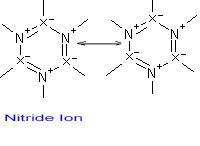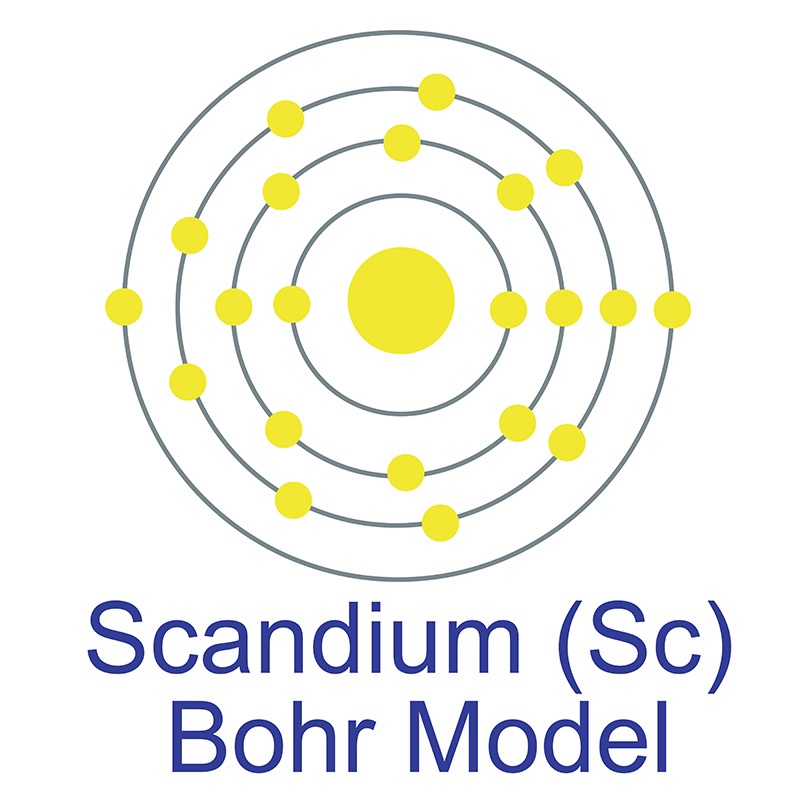SECTION 1. IDENTIFICATION
Product Name: Scandium Nitride
Product Number: All applicable American Elements product codes, e.g. SC-N-02
, SC-N-03
, SC-N-04
, SC-N-05
CAS #: 664347-12-0
Relevant identified uses of the substance: Scientific research and development
Supplier details:
American Elements
10884 Weyburn Ave.
Los Angeles, CA 90024
Tel: +1 310-208-0551
Fax: +1 310-208-0351
Emergency telephone number:
Domestic, North America: +1 800-424-9300
International: +1 703-527-3887
SECTION 2. HAZARDS IDENTIFICATION
2.1 Classification of the substance or mixture
Classification according to Regulation (EC) No 1272/2008
GHS07
Acute Tox. 4 H302 Harmful if swallowed.
Acute Tox. 4 H332 Harmful if inhaled.
Skin Irrit. 2
H315 Causes skin irritation.
Eye Irrit. 2
H319 Causes serious eye irritation.
STOT SE 3 H335 May cause respiratory irritation.
Classification according to Directive 67/548/EEC or Directive 1999/45/EC
Xn; Harmful
R20/22: Harmful by inhalation and if swallowed.
Xi; Irritant
R36/37/38: Irritating to eyes, respiratory system and skin.
Information concerning particular hazards for human and environment:
N/A
Other hazards that do not result in classification
No data available
2.2 Label elements
Labelling according to Regulation (EC) No 1272/2008
The substance is classified and labelled according to the CLP regulation.
Hazard pictograms

GHS07
Signal word
Warning
Hazard statements
H302 Harmful if swallowed.
H332 Harmful if inhaled.
H315 Causes skin irritation.
H319 Causes serious eye irritation.
H335 May cause respiratory irritation.
Precautionary statements
P261
Avoid breathing dust/fume/gas/mist/vapors/spray.
P280
Wear protective gloves/protective clothing/eye protection/face protection.
P305+P351+P338 IF IN EYES: Rinse cautiously with water for several minutes. Remove contact lenses, if present and easy to do. Continue rinsing.
P304+P340
IF INHALED: Remove person to fresh air and keep comfortable for breathing.
P405
Store locked up.
P501
Dispose of contents/container in accordance with local/regional/national/international regulations.
2.3 Other hazards
Results of PBT and vPvB assessment
PBT:
N/A
vPvB:
N/A
SECTION 3. COMPOSITION/INFORMATION ON INGREDIENTS
3.1 Substances
CAS# Designation:
664347-12-0 Scandium nitride
SECTION 4. FIRST AID MEASURES
4.1 Description of first aid measures
If inhaled:
Supply patient with fresh air. If not breathing, provide artificial respiration. Keep patient warm. Consult doctor if symptoms persist.
Seek immediate medical advice.
In case of skin contact:
Instantly wash with water and soap and rinse thoroughly.
Seek immediate medical advice.
In case of eye contact:
Rinse opened eye for several minutes under running water. Then consult doctor.
If swallowed:
Seek medical treatment.
4.2 Most important symptoms and effects, both acute and delayed
No data available
4.3 Indication of any immediate medical attention and special treatment needed
No data available
SECTION 5. FIREFIGHTING MEASURES
5.1 Extinguishing media
Suitable extinguishing agents
CO2, sand, extinguishing powder. Do not use water.
5.2 Special hazards arising from the substance or mixture
If this product is involved in a fire, the following can be released:
Nitrogen oxides (NOx)
Toxic metal oxide smoke
5.3 Advice for firefighters
Protective equipment:
Wear self-contained breathing apparatus.
Wear full protective suit.
SECTION 6. ACCIDENTAL RELEASE MEASURES
6.1 Personal precautions, protective equipment and emergency procedures
Use personal protective equipment. Keep unprotected persons away.
Ensure adequate ventilation
6.2 Environmental precautions:
Do not allow material to be released to the environment without official permits.
6.3 Methods and materials for containment and cleanup:
Dispose of contaminated material as waste according to section 13.
Ensure adequate ventilation.
Prevention of secondary hazards:
No special measures required.
6.4 Reference to other sections
See Section 7 for information on safe handling
See section 8 for information on personal protection equipment.
See Section 13 for information on disposal.
SECTION 7. HANDLING AND STORAGE
7.1 Precautions for safe handling
Keep containers tightly sealed.
Store in cool, dry place in tightly closed containers.
Ensure good ventilation/exhaustion at the workplace.
Information about protection against explosions and fires:
No data available
7.2 Conditions for safe storage, including any incompatibilities
Requirements to be met by storerooms and containers:
No special requirements.
Information about storage in one common storage facility:
Store away from oxidising agents.
Further information about storage conditions:
Keep container tightly sealed.
Store in cool, dry conditions in well-sealed containers.
7.3 Specific end use(s)
No data available
SECTION 8. EXPOSURE CONTROLS/PERSONAL PROTECTION
Additional information about design of technical systems:
Properly operating chemical fume hood designed for hazardous chemicals and having an average face velocity of at least 100 feet per minute.
8.1 Control parameters
Components with critical values that require monitoring at the workplace:
Chromium (III) compounds, as Cr
mg/m3
ACGIH TLV 0.5; A4
Belgium TWA 0.5
Denmark TWA 0.5
Finland TWA 0.01
France VME 0.5
Japan OEL 0.5
Korea TLV 0.5
Netherlands MAC-TGG 0.5
Norway TWA 0.5
Poland TWA 0.5
Sweden NGV 0.5
United Kingdom TWA 0.5
USA PEL 0.5
Additional information:
No data
8.2 Exposure controls
Personal protective equipment
General protective and hygienic measures
The usual precautionary measures should be adhered to in handling the chemicals.
Keep away from foodstuffs, beverages and food.
Instantly remove any soiled and impregnated garments.
Wash hands during breaks and at the end of the work.
Avoid contact with the eyes and skin.
Maintain an ergonomically appropriate working environment.
Breathing equipment:
Use breathing protection with high concentrations.
Protection of hands:
Inspect gloves prior to use.
The selection of the suitable gloves does not only depend on the material, but also on further marks of quality and varies from manufacturer to manufacturer.
Material of gloves
Impervious gloves
Eye protection:
Safety glasses
Face protection
Body protection:
Protective work clothing.
SECTION 9. PHYSICAL AND CHEMICAL PROPERTIES
9.1 Information on basic physical and chemical properties
Appearance:
Form: Solid
Smell: Odorless
Odor threshold: No data available.
pH: N/A
Melting point/Melting range: No data available.
Boiling point/Boiling range: No data available
Sublimation temperature / start: No data available
Flash point: N/A
Inflammability (solid, gas)
Product is not inflammable.
Ignition temperature: No data available
Decomposition temperature: No data available
Self-inflammability: No data available.
Danger of explosion: Product is not explosive.
Critical values for explosion:
Lower: No data available
Upper: No data available
Steam pressure: N/A
Density at 20 °C
No data available.
Relative density
No data available.
Vapor density
N/A
Evaporation rate
N/A
Solubility in Water (H2O): Insoluble
Partition coefficient (n-octanol/water): No data available.
Viscosity:
Dynamic: N/A
Kinematic: N/A
9.2 Other information
No data available
SECTION 10. STABILITY AND REACTIVITY
10.1 Reactivity
No data available
10.2 Chemical stability
Stable under recommended storage conditions.
Thermal decomposition / conditions to be avoided:
No decomposition if used and stored according to specifications.
10.3 Possibility of hazardous reactions
Contact with acids releases flammable gases
10.4 Conditions to avoid
No data available
10.5 Incompatible materials:
Oxidising agents
10.6 Hazardous decomposition products:
Nitrogen oxides (NOx)
Metal oxide
SECTION 11. TOXICOLOGICAL INFORMATION
11.1 Information on toxicological effects
Acute toxicity:
Harmful if inhaled.
Harmful if swallowed.
LD/LC50 values that are relevant for classification:
No data
Skin irritation or corrosion:
Causes skin irritation.
Eye irritation or corrosion:
Causes serious eye irritation.
Sensitization:
No sensitizing effect known.
Germ cell mutagenicity:
No effects known.
Carcinogenicity:
EPA-D: Not classifiable as to human carcinogenicity: inadequate human and animal evidence of carcinogenicity or no data are available.
IARC-3: Not classifiable as to carcinogenicity to humans.
ACGIH A4: Not classifiable as a human carcinogen: Inadequate data on which to classify the agent in terms of its carcinogenicity in humans and/or animals.
Reproductive toxicity:
No effects known.
Specific target organ system toxicity - repeated exposure:
No effects known.
Specific target organ system toxicity - single exposure:
May cause respiratory irritation.
Aspiration hazard:
No effects known.
Subacute to chronic toxicity:
No effects known.
Additional toxicological information:
To the best of our knowledge the acute and chronic toxicity of this substance is not fully known.
SECTION 12. ECOLOGICAL INFORMATION
12.1 Toxicity
Aquatic toxicity:
No data available
12.2 Persistence and degradability
No data available
12.3 Bioaccumulative potential
No data available
12.4 Mobility in soil
No data available
Additional ecological information:
Do not allow material to be released to the environment without official permits.
Water hazard class 1 (Self-assessment): slightly hazardous for water.
Do not allow undiluted product or large quantities to reach groundwater, water courses, or sewage systems.
Avoid transfer into the environment.
12.5 Results of PBT and vPvB assessment
PBT:
N/A
vPvB:
N/A
12.6 Other adverse effects
No data available
SECTION 13. DISPOSAL CONSIDERATIONS
13.1 Waste treatment methods
Recommendation
Hand over to disposers of hazardous waste.
Must be specially treated under adherence to official regulations.
Consult official regulations for proper disposal.
Uncleaned packagings:
Recommendation:
Disposal must be made according to official regulations.
SECTION 14. TRANSPORT INFORMATION
UN-Number
ADR, IMDG, IATA
None
14.2 UN proper shipping name
ADR, IMDG, IATA
None
14.3 Transport hazard class(es)
ADR, IMDG, IATA
Class
None
Packing group
ADR, IMDG, IATA
None
14.5 Environmental hazards:
N/A
14.6 Special precautions for user
N/A
14.7 Transport in bulk according to Annex II of MARPOL73/78 and the IBC
Code
N/A
Transport/Additional information:
Not dangerous according to the above specifications.
SECTION 15. REGULATORY INFORMATION
15.1 Safety, health and environmental regulations/legislation specific for the substance or mixture
Australian Inventory of Chemical Substances
Substance is not listed.
Standard for the Uniform Scheduling of Drugs and Poisons
Substance is not listed.
National regulations
Information about limitation of use:
Employment restrictions concerning young persons must be observed.
For use only by technically qualified individuals.
Water hazard class:
Water hazard class 1 (Self-assessment): slightly hazardous for water.
Other regulations, limitations and prohibitive regulations
ELINCS (European List of Notified Chemical Substances)
Substance is not listed.
Substance of Very High Concern (SVHC) according to the REACH Regulations (EC) No. 1907/2006.
Substance is not listed.
The conditions of restrictions according to Article 67 and Annex XVII of the Regulation (EC) No 1907/2006 (REACH) for the manufacturing, placing on the market and use must be observed.
Substance is not listed.
Annex XIV of the REACH Regulations (requiring Authorisation for use)
Substance is not listed.
15.2 Chemical safety assessment:
A Chemical Safety Assessment has not been carried out.
SECTION 16. OTHER INFORMATION
Safety Data Sheet according to Regulation (EC) No. 1907/2006 (REACH). The above information is believed to be correct but does not purport to be all inclusive and shall be used only as a guide. The information in this document is based on the present state of our knowledge and is applicable to the product with regard to appropriate safety precautions. It does not represent any guarantee of the properties of the product. American Elements shall not be held liable for any damage resulting from handling or from contact with the above product. See reverse side of invoice or packing slip for additional terms and conditions of sale. COPYRIGHT 1997-2022 AMERICAN ELEMENTS. LICENSED GRANTED TO MAKE UNLIMITED PAPER COPIES FOR INTERNAL USE ONLY.

 The scandium atom has a radius of 162 pm and a Van der Waals radius of 216 pm.Scandium was predicted by Dmitri Mendeleev in 1871 and actually discovered and isolated by Lars Nilson in 1879. One of the
The scandium atom has a radius of 162 pm and a Van der Waals radius of 216 pm.Scandium was predicted by Dmitri Mendeleev in 1871 and actually discovered and isolated by Lars Nilson in 1879. One of the  It is occasionally included in the classification of the
It is occasionally included in the classification of the 
